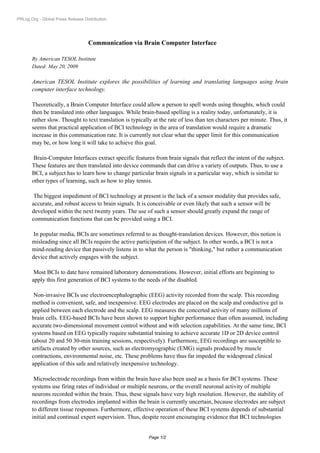
Communication via-brain-computer-interface
- 1. PRLog.Org - Global Press Release Distribution Communication via Brain Computer Interface By American TESOL Institute Dated: May 20, 2009 American TESOL Institute explores the possibilities of learning and translating languages using brain computer interface technology. Theoretically, a Brain Computer Interface could allow a person to spell words using thoughts, which could then be translated into other languages. While brain-based spelling is a reality today, unfortunately, it is rather slow. Thought to text translation is typically at the rate of less than ten characters per minute. Thus, it seems that practical application of BCI technology in the area of translation would require a dramatic increase in this communication rate. It is currently not clear what the upper limit for this communication may be, or how long it will take to achieve this goal. Brain-Computer Interfaces extract specific features from brain signals that reflect the intent of the subject. These features are then translated into device commands that can drive a variety of outputs. Thus, to use a BCI, a subject has to learn how to change particular brain signals in a particular way, which is similar to other types of learning, such as how to play tennis. The biggest impediment of BCI technology at present is the lack of a sensor modality that provides safe, accurate, and robust access to brain signals. It is conceivable or even likely that such a sensor will be developed within the next twenty years. The use of such a sensor should greatly expand the range of communication functions that can be provided using a BCI. In popular media, BCIs are sometimes referred to as thought-translation devices. However, this notion is misleading since all BCIs require the active participation of the subject. In other words, a BCI is not a mind-reading device that passively listens in to what the person is "thinking," but rather a communication device that actively engages with the subject. Most BCIs to date have remained laboratory demonstrations. However, initial efforts are beginning to apply this first generation of BCI systems to the needs of the disabled. Non-invasive BCIs use electroencephalographic (EEG) activity recorded from the scalp. This recording method is convenient, safe, and inexpensive. EEG electrodes are placed on the scalp and conductive gel is applied between each electrode and the scalp. EEG measures the concerted activity of many millions of brain cells. EEG-based BCIs have been shown to support higher performance than often assumed, including accurate two-dimensional movement control without and with selection capabilities. At the same time, BCI systems based on EEG typically require substantial training to achieve accurate 1D or 2D device control (about 20 and 50 30-min training sessions, respectively). Furthermore, EEG recordings are susceptible to artifacts created by other sources, such as electromyographic (EMG) signals produced by muscle contractions, environmental noise, etc. These problems have thus far impeded the widespread clinical application of this safe and relatively inexpensive technology. Microelectrode recordings from within the brain have also been used as a basis for BCI systems. These systems use firing rates of individual or multiple neurons, or the overall neuronal activity of multiple neurons recorded within the brain. Thus, these signals have very high resolution. However, the stability of recordings from electrodes implanted within the brain is currently uncertain, because electrodes are subject to different tissue responses. Furthermore, effective operation of these BCI systems depends of substantial initial and continual expert supervision. Thus, despite recent encouraging evidence that BCI technologies Page 1/2
- 2. PRLog.Org - Global Press Release Distribution based on microelectrodes may be useful to people with paralysis, the difficulties described above currently impede widespread clinical implementation of such invasive BCI technologies. A final sensor method uses electrodes that are placed on the surface of the brain (electrocorticography (ECoG)). These sensors measure local field potential activity that captures brain signal changes on the order of millimeters (rather than a tenth of a millimeter captured by an implanted microelectrode). ECoG electrodes are in direct contact with the brain, and thus do not need the application of any conductive gel. This methodology could be a powerful but yet practical alternative EEG and microelectrodes. ECoG has higher fidelity than EEG and far less vulnerability to artifacts such as EMG. At the same time, because ECoG electrodes do not penetrate the brain, they are likely to have greater long-term stability compared to implanted microelectrodes. Development and implementation of a Brain-Computer Interface (BCI) system is complex and time consuming. In response to this problem, Dr. Gerwin Schalk has been developing a general-purpose system for BCI research, called BCI2000. BCI2000 has been in development since 2000 in a project led by the Brain-Computer Interface R&D Program at the Wadsworth Center of the New York State Department of Health in Albany, New York, USA. American TESOL Institute interviewed Dr. Schalk in May of 2009 about the possibilities of learning and translating languages utilizing BCI technology. ### American TESOL Institute provides online or in-class TESOL certification programs, R & D for language learning programs, and ESL programs worldwide. Category Science, Medical Tags tesol, tefl, learning languages, bci, Research, esl, Technology, Education, future Email Click to email author Phone 813-975-7404 Fax 813-464-8032 Address 8875 Hidden River Parkway STE: 300 City/Town Tampa State/Province Florida Zip 33637 Country United States Page 2/2
